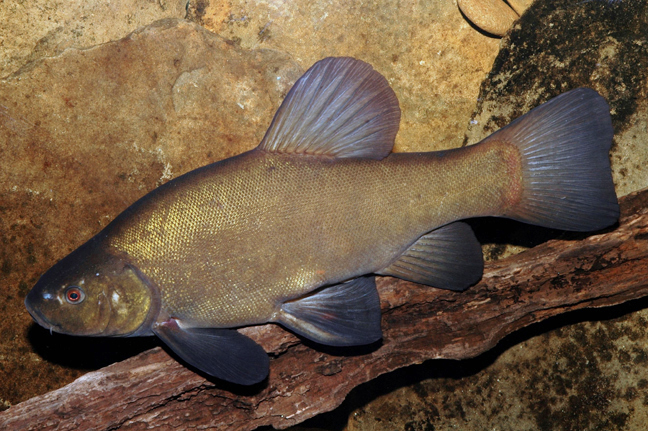Tench, Tinca tinca (Linnaeus 1758)

Tench, Tinca tinca. Source: Tarmo A. Raadik / Arthur Rylah Institute. License: All rights reserved
Tench, Tinca tinca (Linnaeus 1758)
More Info
|
Distribution |
Introduced from Europe to the Murray-Darling basin in NSW, SA and VIC (approximately 147°00’E) and also Derwent River TAS (45°45’S); temperate; inhabiting slow-flowing or still waters, often with a muddy bottom and abundant aquatic plants; often in backwaters, lagoons and deep sheltered holes. |
|
Features |
D III, 8; A III, 6-8; P 17-19; V 9 Body elongate and thickset; dorsal profile convex from above eye to deep, short caudal peduncle; head large, triangular; snout long and blunt; eyes small, orange-red in colour; mouth terminal, small to moderate size, gape not reaching anterior border of eye; jaws equal, without teeth; lips thick, fleshy; small barbel at each corner of mouth. Cycloid scales, very small, thin, embedded; skin covered with heavy mucous; lateral line scales 91-120. Fins rounded and thick; single, short-based, high and rounded dorsal fin in middle of back; anal fin smaller than dorsal but similar in shape, deep and rounded; pectoral fins large, rounded, well forward, low; ventral fins abdominal, large, rounded, close together; caudal fin slightly forked with rounded lobes |
|
Size |
Maximum size to 70 cm but most range between 10 and 30 cm. |
|
Colour |
Greenish olive with gold iridescence on cheek, gill cover and side of body. |
|
Feeding |
Adults are generally benthic carnivores with a diet that includes mainly aquatic insects (chironomids, mudeyes, mayflies) and micro-crustaceans (cladocera, ostracods, amphipods, copepods), with some molluscs, worms and plant material. Smaller Tench feed on microcrustaceans and small chironomids and larval Tench feed on plankton and small insect larvae and crustaceans. |
|
Biology |
Mature at 3-4 years. Oviparous benthic spawners. Spawning occurs in spring and summer. Females produce 300 000-900 000 eggs in 3-4 batches approximately every 2 weeks that are laid in shallow water, usually on weeds. Eggs are small and adhesive. Larvae hatch after 3-6 days at 4-5 mm TL. |
|
Species Citation |
Cyprinus tinca Linnaeus C. (1758). Systema Naturae. Holmiae: Salvii 10th Ed 824 pp. Europe. |
|
Author |
Martin F. Gomon |
Tench, Tinca tinca (Linnaeus 1758)
References
Allen et al 2002
Cadwallader & Backhouse
Hoese et al Catalogue
Lintermans 2007





